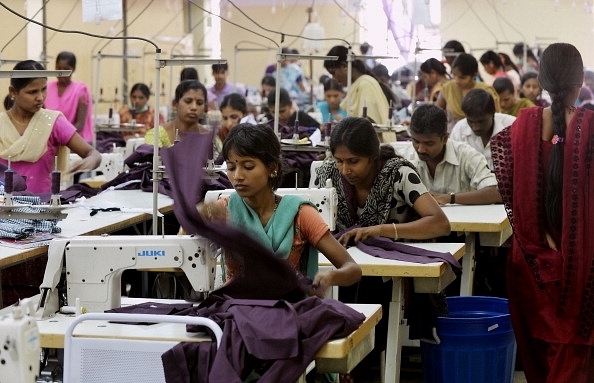Economy
Latest Data Should End Debate On Whether DeMo Hurt Economy. It Did.
- Ever since operation demonetisation took off, a debate has raged on about whether the exercise hurt the economy.
- The sceptics have been proved right. Demonetisation did hurt the economy.
- The government should now stop trying to give a spin to the numbers and focus on nursing the economy back to 8 per cent growth.

Indian labourers in a factory (Manjunath Kiran/AFP/Getty Images)
Well, there’s no getting away from it – operation demonetisation has dealt a blow to the economy. Growth in gross domestic product (GDP) 2016-17 slipped to 7.1 per cent from 8 per cent in 2015-16. So did growth in gross value added (GVA) – from 7.9 per cent to 6.6 per cent.
A quick reminder: the data released on 31 May has been compiled using the new series of the index of industrial production (IIP) and wholesale price index (WPI), and earlier figures have been revised as well.
Why is demonetisation to blame? It had taken place a little over a month into the third quarter (Q3, October-December) and the growth numbers for that quarter – 7 per cent (6.9 per cent post-revision) – had been a surprise. They had seemed to indicate that the economy had shrugged off the exercise as a minor irritant; the sceptics said wait for the Q4 (January-March) numbers.
Well, the Q4 numbers are not very pretty. GDP growth came down to 6.1 per cent from 6.9 per cent in Q3. GVA growth fell to 5.6 per cent in Q4 from 6.7 per cent in Q3. The sceptics have been proven right.
Or have they? Chief Statistician T C A Anant was constantly asked about the effect of demonetisation on growth and he had a stock response, roughly this: just because something happened after a particular development or policy, it may not be right to identify just that as a cause; sophisticated calculations need to be done to find out the effect; we want an analysis after three months, but it will not be statistically robust. Well, till such time as statisticians do their econometric exercises, this is the only explanation that is available and people will run with it.
The decline cuts across sectors, barring agriculture and government; GVA in these two sectors grew 4.9 per cent and 11.3 per cent respectively in 2016-17 against 0.7 per cent and 6.9 per cent in 2015-16. But agriculture was dealing with a drought in 2015-16; it gained from a good monsoon in 2016-17.
When one looks at quarter-on-quarter performance, only mining and government did better in Q4 than in Q3. The construction industry was the worst hit, with GVA growth declining 3.7 per cent in Q4 from a growth of 3.4 per cent in Q3. Manufacturing slumped from 8.2 per cent to 5.3 per cent; so did trade, hotels, transport, communications, from 8.3 per cent to 6.5 per cent. The financial, real estate and professional services sector also saw growth dipping from 3.3 per cent to 2.2 per cent. According to Devendra Pant, chief economist, India Ratings, this was because of subdued credit growth, though banks were flush with cash.
Private consumption has also been hit; its share in GDP fell from 61.6 per cent in Q3 to 58.7 per cent in Q4. The explanation that Q3 consumption was not hit hugely because there had been a surge in festival time spending just before demonetisation appears to hold out. In the full year, however, private consumption logged higher growth – from 6.1 per cent in 2015-16 to 8.7 per cent in 2016-17. Its share in GDP also increased from 58 per cent to 58.8 per cent.
In fact, it is private consumption, government expenditure and exports which appear to have kept the economy’s head above water. Government expenditure surged from 3.3 per cent in 2015-16 to 20.8 per cent in 2016-17. And exports staged a smart recovery from a de-growth of minus 5.3 per cent to growth of 4.5 per cent.
The private investment story continues to disappoint, whichever way one looks at it. Growth in 2016-17 was only 2.4 per cent, down from 6.5 per cent in 2015-16. Its share in GDP fell to 29.5 per cent, from 30.9 per cent in 2015-16. Through 2016-17, quarter on quarter, its share in GDP kept declining.
Should these figures be surprising? Not really. Even the chief economic adviser Arvind Subramaniam had indicated that demonetisation would have a negative impact that would last for some time. The growth data has clearly put an end to the debate about whether or not demonetisation has been good for the economy – it clearly hasn’t. The government should now give up trying to give a spin to these numbers. Instead, it should just concentrate its energies on nurturing the economy back to 8 per cent growth.
Support Swarajya's 50 Ground Reports Project & Sponsor A Story
Every general election Swarajya does a 50 ground reports project.
Aimed only at serious readers and those who appreciate the nuances of political undercurrents, the project provides a sense of India's electoral landscape. As you know, these reports are produced after considerable investment of travel, time and effort on the ground.
This time too we've kicked off the project in style and have covered over 30 constituencies already. If you're someone who appreciates such work and have enjoyed our coverage please consider sponsoring a ground report for just Rs 2999 to Rs 19,999 - it goes a long way in helping us produce more quality reportage.
You can also back this project by becoming a subscriber for as little as Rs 999 - so do click on this links and choose a plan that suits you and back us.
Click below to contribute.
Latest